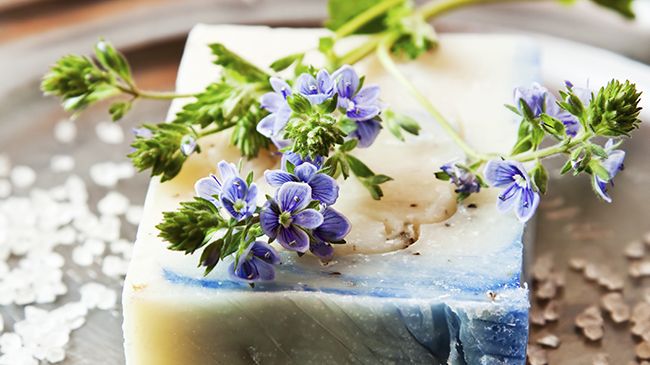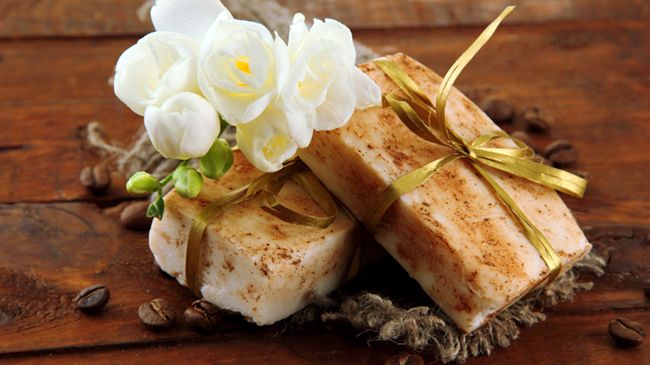I think it is safe to say that most naturals who have dabbled in DIY recipes for their own tresses feel comfortable working with natural oil blends, conditioners, and even gels. Shampoos or shampoo bars on the other hand may seem a tad taxing from the outset, as the main component of the task is to cleanse, and cleansing means working with surfactants.
Don’t Be Intimidated
A surfactant or detergent molecule is one that possesses the trait of having one distinct portion of the molecule that is polar and hydrophilic (water-loving”>, and one portion that is non-polar and hydrophobic (water-fearing”>. To many this sounds intimidating but it can be merely a challenge once you understand what you need is a cleansing product that will do what it is intended to do without drying out your tresses. No one needs or wants that type of headache, so before you start whipping up everything in your kitchen we need to understand what we are doing and why.
Shampoos can be drying, especially if they contain harsh surfactants like sodium lauryl sulfate (SLS”>. This additive that makes your cleansing products foam has been linked to cancer, neurotoxicity, organ toxicity, skin irritation, and endocrine disruption according to Livestrong. It is an emulsifier and foaming agent but it is not necessary to clean your hair. If you are already squeamish about it then no worries because what is the point in creating a product and making it harmful to your hair? We are not in that type of business.
Why a Shampoo Bar Might Be Better than Your Shampoo
Creating a shampoo has its own benefits, but creating a shampoo bar has even more. They tend to be free of silicones and sulfates and chock-full with natural oils. Many using them love the effects they have on their tresses and they gently cleanse without drying out or harming the hair. Another benefit is there is no SLS, and although shampoo bars have negatively charged surfactants, Curl Chemist says “The difference is that the polar head group of the molecule is a carboxylate, rather than a sulfate (R-COO-Na+ vs. R-OSO3-Na+”>, which results in a milder surfactant.” Lye is used in the making of shampoo bars but calm your nerves. It is completely consumed in the chemical reaction and will not irritate or burn your hair or skin. Be very careful when working with lye and use a lye calculator as all the shampoo bar makers suggest, like Soap Cal.net! Now, are we ready for some amazing recipes?
Horsetail Shampoo Bar Recipe for Dry Hair
So many curlies, naturals, and wavies have dry hair so it makes sense to find a recipe that is created to combat that popular issue and with winter coming we are more than ready for the task.
Ingredients
- 8 oz coconut oil
- 8 oz olive oil
- 8 oz organic, sustainably-sourced palm oil
- 4 oz shea butter
- 2 oz cocoa butter
- 3 oz castor oil
- 10 oz handmade horsetail water infusion
- 1 tbsp horsetail powder
- 2 oz argan oil
- 2 oz essential oil blend of ylang ylang, bay, clary sage, sweet orange, and cedarwood
Shea Butter & Citrus Shampoo Bar for Oily Hair
The Citrus in this shampoo bar is perfect for breaking up excess oils.
Ingredients
- 5 oz olive oil
- 3 oz castor oil
- 2 oz shea butter
- 4 oz coconut oil
- 2 oz avocado oil
- 2 oz lye
- 6 oz water
- 1/2 oz lemon essential oil
Therapeutic Homemade Shampoo Recipe for Normal Hair
Ingredients
- 9.5 oz (270ml”> mineral water
- 2 chamomile teabags
- 24.5 oz olive oil
- 3.5 oz sweet almond oil
- 2 oz beeswax
- 2 oz creamed coconut
- 4 oz lye (sodium hydroxide/caustic soda”>
- 4 tsp bergamot essential oil
- 2 tsp lavender essential oil
- 1 tsp geranium essential oil
- 1 tsp rosemary essential oil
Do you make shampoo bars? Do you want to?



